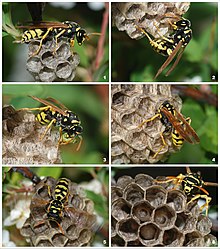This is an old revision of this page, as edited by 70.89.96.5 (talk) at 13:53, 4 March 2020 (→Species). The present address (URL) is a permanent link to this revision, which may differ significantly from the current revision.
Revision as of 13:53, 4 March 2020 by 70.89.96.5 (talk) (→Species)(diff) ← Previous revision | Latest revision (diff) | Newer revision → (diff) Vespid wasps that gather fibers from dead wood and plant stems
| Paper Wasp | |
|---|---|

| |
| A young paper wasp queen (Polistes dominula) starting a new colony | |
| Scientific classification | |
| Kingdom: | Animalia |
| Phylum: | Arthropoda |
| Class: | Insecta |
| Order: | Hymenoptera |
| Suborder: | Apocrita |
| Family: | Vespidae |
| Subfamily: | Polistinae, Stenogastrinae, or Vespinae |
Paper wasps are vespid wasps that gather fibers from dead wood and plant stems, which they mix with saliva, and use to construct water-resistant nests made of gray or brown papery material. Some types of paper wasps are also sometimes called umbrella wasps, due to the distinctive design of their nests.
\ate = 1994|journal = Psyche|accessdate = |doi =10.1155/1994/92839 |pmid = |last2 = Ito|first2 = Yosiaki|issue = 3–4|pages = 145–158|volume = 101}}</ref>
Three species of Polistes are obligate social parasites, and have lost the ability to build their own nests, and are sometimes referred to as "cuckoo paper wasps". They rely on the nests of their hosts to raise their brood.
Behavior
Unlike yellowjackets and hornets, which can be very aggressive, polistine paper wasps will generally only attack if they themselves or their nest are threatened. Since their territoriality can lead to attacks on people, and because their stings are quite painful and can produce a potentially fatal anaphylactic reaction in some individuals, nests in human-inhabited areas may present an unacceptable hazard. A study conducted on European paper wasps (Polistes dominula) concluded that wasps with brighter aposematic colors are more venomous, because they have larger poison glands, and offer a stronger warning signal to organisms threatening the nest.

Most wasps are beneficial in their natural habitat, and are critically important in natural biocontrol. Paper wasps feed on nectar and other insects, including caterpillars, flies, and beetle larvae. Because they are a known pollinator and feed on known garden pests, paper wasps are often considered to be beneficial by gardeners.
See also
References
- "Paper Wasp" Microsoft Encarta Online Encyclopedia 2006.
- Dapporto L, Cervo R, Sledge MF, Turillazzi S (2004) "Rank integration in dominance hierarchies of host colonies by the paper wasp social parasite Polistes sulcifer (Hymenoptera, Vespidae)". J Insect Physiol 50 :217–223
- Felixson, Carol (undated). "Paper wasps work together." Retrieved 2009-04-26 from "L.A. Times" at http://www.latimes.com/features/kids/readingroom/la-et-kidcal5mar06,1,7872696.story.
- ^ Drees, B.M. and John Jackman (1999). Field Guide to Texas Insects. Gulf Publishing Company, Houston, Texas. Excerpt available at: Texas Cooperative extension Archived 2006-12-05 at the Wayback Machine
- Vidal-Cordero, J; Moreno-Rueda, Gregorio; López-Orta, Antonio; Marfil-Daza, Carlos; Ros-Santaella, José L; Ortiz-Sánchez, F (2012). "Brighter-colored paper wasps (Polistes dominula) have larger poison glands". Frontiers in Zoology. 9 (1): 20. doi:10.1186/1742-9994-9-20. ISSN 1742-9994. PMC 3495029. PMID 22901602.
{{cite journal}}: CS1 maint: unflagged free DOI (link) - Cite error: The named reference
OSUwas invoked but never defined (see the help page).
External links
- National Geographic News: Wasps Can Recognize Faces. Retrieved 2012-12-04.